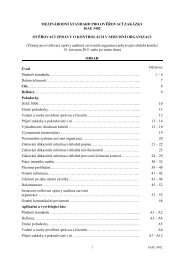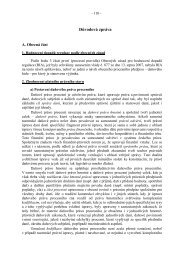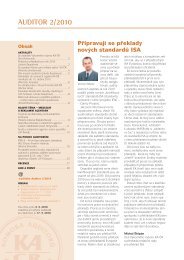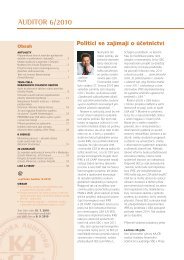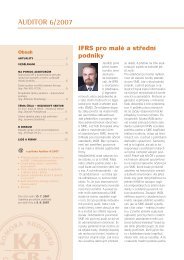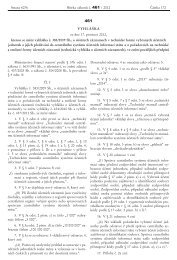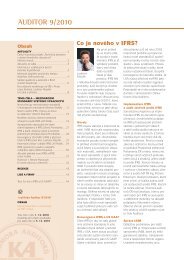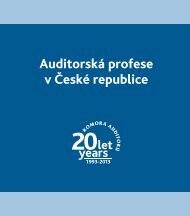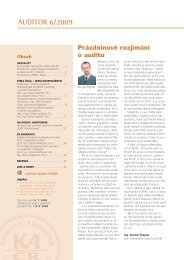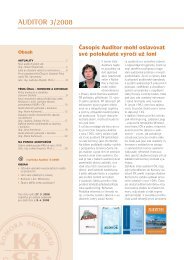Guide to Using International Standards on Auditing in - IFAC
Guide to Using International Standards on Auditing in - IFAC
Guide to Using International Standards on Auditing in - IFAC
You also want an ePaper? Increase the reach of your titles
YUMPU automatically turns print PDFs into web optimized ePapers that Google loves.
128<br />
<str<strong>on</strong>g>Guide</str<strong>on</strong>g> <str<strong>on</strong>g>to</str<strong>on</strong>g> <str<strong>on</strong>g>Us<strong>in</strong>g</str<strong>on</strong>g> <str<strong>on</strong>g>Internati<strong>on</strong>al</str<strong>on</strong>g> <str<strong>on</strong>g>Standards</str<strong>on</strong>g> <strong>on</strong> <strong>Audit<strong>in</strong>g</strong> <strong>in</strong> the Audits of Small- and Medium-Sized Entities Volume 1—Core C<strong>on</strong>cepts<br />
Purpose<br />
Tests of c<strong>on</strong>trols are tests designed <str<strong>on</strong>g>to</str<strong>on</strong>g> obta<strong>in</strong> audit evidence about the operat<strong>in</strong>g effectiveness of c<strong>on</strong>trols.<br />
C<strong>on</strong>trols can prevent material misstatements at the asserti<strong>on</strong> level from occurr<strong>in</strong>g al<str<strong>on</strong>g>to</str<strong>on</strong>g>gether, or detect and<br />
then correct them after they have occurred. The c<strong>on</strong>trols selected for test<strong>in</strong>g would be those that provide<br />
necessary audit evidence for a relevant asserti<strong>on</strong>.<br />
CONSIDER POINT<br />
A walk-through procedure <str<strong>on</strong>g>to</str<strong>on</strong>g> determ<strong>in</strong>e whether a c<strong>on</strong>trol has been implemented is not a test of<br />
c<strong>on</strong>trols. It is a risk assessment procedure, the results of which may determ<strong>in</strong>e whether tests of c<strong>on</strong>trols<br />
would be useful, and if so, how they would be designed.<br />
Tests of c<strong>on</strong>trols are c<strong>on</strong>sidered by the audi<str<strong>on</strong>g>to</str<strong>on</strong>g>r when:<br />
• The risk assessment is based <strong>on</strong> an expectati<strong>on</strong> that <strong>in</strong>ternal c<strong>on</strong>trol operates effectively; or<br />
• Substantive procedures al<strong>on</strong>e will not provide sufficient appropriate audit evidence at the asserti<strong>on</strong><br />
level. This might apply where sales are made over the Internet and no documentati<strong>on</strong> of transacti<strong>on</strong>s is<br />
produced or ma<strong>in</strong>ta<strong>in</strong>ed, other than through the IT system.<br />
Select<strong>in</strong>g sample sizes for tests of c<strong>on</strong>trols is addressed <strong>in</strong> Volume 2, Chapter 17 <strong>on</strong> the extent of test<strong>in</strong>g.<br />
Tests of c<strong>on</strong>trols are designed <str<strong>on</strong>g>to</str<strong>on</strong>g> obta<strong>in</strong> audit evidence about:<br />
• How <strong>in</strong>ternal c<strong>on</strong>trol procedures were applied throughout, or at relevant times dur<strong>in</strong>g, the period under<br />
audit. If substantially different c<strong>on</strong>trols were used at different times dur<strong>in</strong>g the period, each c<strong>on</strong>trol<br />
system should be c<strong>on</strong>sidered separately;<br />
• The c<strong>on</strong>sistency with which <strong>in</strong>ternal c<strong>on</strong>trol procedures were applied; and<br />
• By whom or by what means c<strong>on</strong>trols were applied.<br />
CONSIDER POINT<br />
When audit<strong>in</strong>g smaller entities, audi<str<strong>on</strong>g>to</str<strong>on</strong>g>rs often plan <str<strong>on</strong>g>to</str<strong>on</strong>g> perform substantive procedures, <strong>on</strong> the<br />
assumpti<strong>on</strong> that tests of exist<strong>in</strong>g c<strong>on</strong>trol activities would not be practical due <str<strong>on</strong>g>to</str<strong>on</strong>g> limited segregati<strong>on</strong> of<br />
duties, etc. Before jump<strong>in</strong>g <str<strong>on</strong>g>to</str<strong>on</strong>g> that c<strong>on</strong>clusi<strong>on</strong>, c<strong>on</strong>sider:<br />
• The strength of the c<strong>on</strong>trol envir<strong>on</strong>ment and other elements of <strong>in</strong>ternal c<strong>on</strong>trol;<br />
• Existence of c<strong>on</strong>trol activities over asserti<strong>on</strong>s where it would be more efficient <str<strong>on</strong>g>to</str<strong>on</strong>g> ga<strong>in</strong> evidence<br />
through tests of c<strong>on</strong>trols; and<br />
• Asserti<strong>on</strong>s where substantive procedures al<strong>on</strong>e will not reduce the risks of material misstatement<br />
<str<strong>on</strong>g>to</str<strong>on</strong>g> an acceptably low level. For <strong>in</strong>stance, this may be the case for the completeness of revenues.




